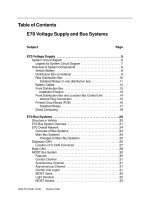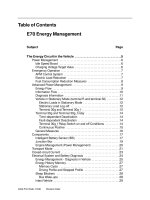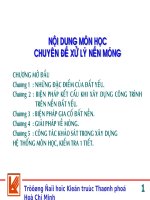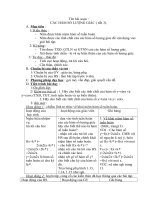C771 03
Bạn đang xem bản rút gọn của tài liệu. Xem và tải ngay bản đầy đủ của tài liệu tại đây (20.97 KB, 2 trang )
Designation: C 771 – 03
Standard Test Method for
Weight Loss After Heat Aging of Preformed Tape Sealants1
This standard is issued under the fixed designation C 771; the number immediately following the designation indicates the year of
original adoption or, in the case of revision, the year of last revision. A number in parentheses indicates the year of last reapproval. A
superscript epsilon (e) indicates an editorial change since the last revision or reapproval.
5. Significance and Use
5.1 Preformed tape sealants are tacky, deformable solids
that are used under compression between two substrates in a
variety of sealing applications. Compared to other types of
sealants, that is, gunnable sealants and caulks, sealing tapes are
designed to be essentially 100 % solids materials. In use, these
tapes are intended to give long service with minimal weight
loss or volatility. This procedure will give a measure of the
weight loss of a preformed tape sealant after a controlled
period of exposure at an elevated temperature.
1. Scope
1.1 This test method covers a laboratory procedure for
determining the weight loss after heat aging of preformed tape
sealants.
NOTE 1—Test Method C 681 describes a weight loss or volatility test
for knife-grade glazing compounds.
1.2 The values stated in acceptable metric units are to be
regarded as the standard. The values given in parentheses are
for information only.
1.3 The subcommittee with jurisdiction is not aware of any
similar ISO standard.
1.4 This standard does not purport to address all of the
safety concerns, if any, associated with its use. It is the
responsibility of the user of this standard to establish appropriate safety and health practices and determine the applicability of regulatory limitations prior to use.
6. Apparatus
6.1 Balance, calibrated to weigh specimens to the nearest
0.01 g.
6.2 Thin Plates of Aluminum or Other Metal, two, not less
than 51 mm (2 in.) wide by 152 mm (6 in.) long, for each tape
to be tested.
6.3 Vented Air Circulating Oven, that complies with Specification E 145 and is capable of aging samples at 100 6 2°C
(212 6 3.6°F).
2. Referenced Documents
2.1 ASTM Standards:
C 681 Test Method for Volatility of Oil- and Resin-Based,
Knife-Grade, Channel Glazing Compounds2
C 717 Terminology of Building Seals and Sealants2
E 145 Specification for Gravity-Convection and ForcedVentilation Ovens3
7. Sampling
7.1 Use a fresh roll of preformed tape sealant for testing.
Remove a section of preformed tape sealant approximately 61
cm (2 ft) long from the roll and discard.
7.2 Remove release paper as required in order to fashion a
suitable test specimen.
3. Terminology
3.1 Definitions—The definitions of the following terms used
in this test method are found in Terminology C 717: preformed
tape sealant, sealant.
8. Procedure
8.1 For each preformed tape sealant to be tested, prepare
two test specimens as follows:
8.1.1 Clean and dry two metal plates, weight them, and
record the tare weight for each to the nearest 0.01 g.
8.1.2 Cut the preformed tape sealant into 127-mm (5.0-in.)
lengths. Ply strips together to form on each specimen plate a
solid block of preformed tape sealant not less than 38 mm (1.5
in.) wide by 3 mm (0.12 in.) thick by 127 mm (5.0 in.) long.
8.1.3 Weight the plates with the preformed tape sealant on
them, subtract the tare weights of the plates, and determine and
record the initial net weight for each test specimen to the
nearest 0.01 g.
4. Summary of Test Method
4.1 The preformed tape sealant to be tested is placed on a
tared metal plate and weighed. After heat aging, the specimen
is weighed again. The difference in weight indicates the
volatile content of the tape sealant.
1
This test method is under the jurisdiction of ASTM Committee C24 on Building
Seals and Sealants and is the direct responsibility of Subcommittee C24.20 on
General Sealant Standards.
Current edition approved May 10, 2003. Published June 2003. Originally
approved in 1974. Last previous edition approved in 1997 as C 771 – 97.
2
Annual Book of ASTM Standards, Vol 04.07.
3
Annual Book of ASTM Standards, Vol 14.04.
Copyright © ASTM International, 100 Barr Harbor Drive, PO Box C700, West Conshohocken, PA 19428-2959, United States.
1
C 771 – 03
10. Report
10.1 Identification of the preformed tape sealant, that is, the
name, lot number, and any other identifying characteristics.
10.2 Report the average of at least two weight loss calculations for each sample tested.
8.2 Place both specimens in an air circulating oven preset to
100 6 2°C (212 6 3.6°F) and condition them for 1 week at this
temperature.
8.3 After conditioning, remove the specimens from the oven
and allow them to cool at room temperature for 1 h.
8.4 Reweigh each specimen to the nearest 0.01 g and record.
8.5 Subtract the respective tare weights of the plates from
the weight of the specimens to determine the net weight of the
tape specimen after heat aging, and record these weights to the
nearest 0.01 g.
11. Precision and Bias
11.1 Interlaboratory round-robin testing of the weight loss
of various sealing tapes has determined the 2 s or 95 %
confidence level of precision for the preformed tape sealant
weight loss test.
11.2 The interlaboratory or multioperator precision for preformed tape sealants that show less than 3 % total weight loss
is 60.5 %.
11.3 The interlaboratory or multioperator precision for preformed tape sealants that show greater than 3 % total weight
loss is 61.0 %.
9. Calculation
9.1 For each specimen, determine the weight loss of the
preformed tape sealant by subtracting the net weight of the
preformed tape sealant after heat aging from its initial net
weight.
9.2 Calculate the percent weight loss for each test specimen
by dividing the weight loss by the initial net weight of the tape
specimen times 100.
12. Keywords
12.1 preformed tape sealants; tapes; tape sealants; weight
loss; weight loss after heat aging
ASTM International takes no position respecting the validity of any patent rights asserted in connection with any item mentioned
in this standard. Users of this standard are expressly advised that determination of the validity of any such patent rights, and the risk
of infringement of such rights, are entirely their own responsibility.
This standard is subject to revision at any time by the responsible technical committee and must be reviewed every five years and
if not revised, either reapproved or withdrawn. Your comments are invited either for revision of this standard or for additional standards
and should be addressed to ASTM International Headquarters. Your comments will receive careful consideration at a meeting of the
responsible technical committee, which you may attend. If you feel that your comments have not received a fair hearing you should
make your views known to the ASTM Committee on Standards, at the address shown below.
This standard is copyrighted by ASTM International, 100 Barr Harbor Drive, PO Box C700, West Conshohocken, PA 19428-2959,
United States. Individual reprints (single or multiple copies) of this standard may be obtained by contacting ASTM at the above
address or at 610-832-9585 (phone), 610-832-9555 (fax), or (e-mail); or through the ASTM website
(www.astm.org).
2





![MAKE magazine [OH] 03](https://media.store123doc.com/images/document/13/ce/fj/medium_fjg1388298702.jpg)



